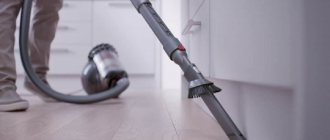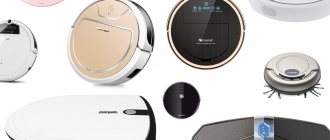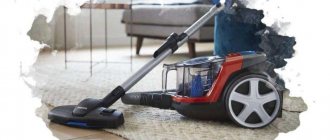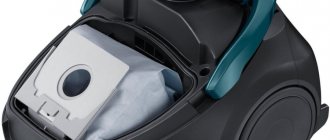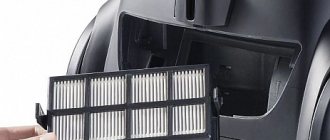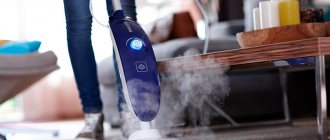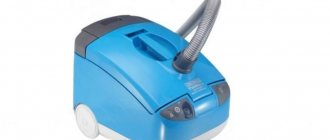Modern vacuum cleaners use a variety of attachments. One of the most popular and indispensable is a turbo brush, which will help you quickly and effectively remove debris from both smooth surfaces (parquet, tiles, furniture, curtains) and fluffy surfaces (rugs, carpet, fluffy carpets). A turbo brush can clean labor-intensive areas, for example, clean surfaces from threads, hair, animal hair, and feathers. Most models are small in size and light in weight, which allows you to quickly and efficiently clean the room, saving time and effort. We will tell you about the types of turbo brushes for vacuum cleaners, the rules for their use, and give recommendations on choosing this useful attachment.
What is a turbo brush and why is it needed?
An attachment to a vacuum cleaner in the form of a rotating roller with stiff bristles arranged on it in a spiral is called a turbo brush. The movement is produced by aerodynamic force or an electric motor. The intensity of roller rotation depends on the surface being cleaned. If the surface is soft (carpet, furniture) - the roller rotates faster, if the surface is hard (tiles, parquet, linoleum) - slower. In order to effectively remove debris using such a nozzle, you need to slowly move it several times over the surface to be cleaned.
How to properly clean a turbo brush for a vacuum cleaner from hair and fur?
Our housekeeping expert
Hello, Polina! First, let's look at how the device works. There are mechanical and electrically driven brushes. The former work due to the force of the sucked air: the higher the power of the vacuum cleaner, the better the device can clean the surface. Electrically driven brushes are much more expensive, but they do not depend on power, since the roller rotates autonomously. True, such a miracle of technology can “overdo it” and pull fibers out of the carpet along with the dust. The choice is yours.
Most often, simple mechanical brushes are used, which are included with the vacuum cleaner.
If you don't already have such a device, be sure to buy one at your local hardware store.
Such a nozzle is inexpensive, but the benefits are simply enormous. And for it to work properly, all parts must sometimes be cleaned of debris.
Regular care
You should not clean the turbo brush after each use of the vacuum cleaner. But there is no need to delay this either. After you have vacuumed the apartment 3-4 times, it’s time to free the roller from the tangled hair. For this:
- Remove the turbo brush from the vacuum cleaner pipe.
- Lightly press the handle until the latch moves slightly.
- Remove the protective cover.
- Wipe the surface with a dry cloth to remove dust and debris.
- Using tweezers and scissors, free the roller from fur and hair.
- Remove the cover in the area of the blades and remove all dirt from there.
- Close the lid.
This is quite enough for the roller to work properly again. However, after a while, such cleaning no longer helps, so you have to disassemble the nozzle and clean it from the inside.
How to disassemble and clean the turbo brush
It is advisable to clean this vacuum cleaner attachment more thoroughly once every six months. To do this you need to disassemble it:
- Remove the protective cover.
- Turn the nozzle over. On the inside you will see 6 screws. Unscrew them using a screwdriver.
- Carefully separate the brush into two halves.
- Wipe the inside surface with a clean cloth. Hard-to-reach places can be cleaned with a vacuum cleaner pipe.
- Remove hair, fur and dirt from all parts of the mechanism. To do this, you can use the same tweezers and scissors.
- Collect the brush.
That's the whole cleaning process. In principle, this is not difficult to do even without outside help. If there are pets in the house, then the nozzle will have to be disassembled every 3 months, then it will be able to work with maximum power.
Types of turbo brushes for vacuum cleaners
There are several types of turbo brushes for vacuum cleaners: mechanical, electric and universal. Let's take a closer look at their main characteristics.
Universal turbo brushes
Such turbo brushes are used in many electric or mechanical vacuum cleaners, but may not function in models with low dust suction power. Produced by LG, Electrolux, Samsung.
Mechanical turbo brushes for vacuum cleaners
In these nozzles, the rotation of the mechanism occurs due to the air flow, which is sucked by the vacuum cleaner. The more powerful the vacuum cleaner, the more intense the rotation. Mechanical ones are less efficient than electric ones, but are easier to operate and cheaper.
Electric turbo brushes for vacuum cleaners
The quality of operation of such a nozzle does not depend on the power of the vacuum cleaner, since the rotation of the roller occurs from a motor connected to the power supply. This attachment performs the function of a mini vacuum cleaner.
There are two types of vacuum cleaner models with a turbo brush:
- for dry cleaning;
- for wet cleaning.
For dry cleaning
Such models are used when cleaning surfaces that do not tolerate moisture: floors, upholstered and cabinet furniture, some types of carpet and rugs.
There are 5 types of vacuum cleaners for dry cleaning: full-size, vertical, combined, manual, compact.
| Name | Characteristics | What are they intended for? |
| Full size | Multifunctional, with large dust collectors. | For general cleaning of premises. |
| Vertical | They remove dirt and dust well in hard-to-reach places, fight allergens, and take up little space. | For fast, effective cleaning. |
| Combined | Equipped with a large container, easy to use. | For cleaning large flat surfaces during construction work. |
| Manual | Small and light, low noise, maneuverable. | For cleaning small apartments. |
| Compact | Lightweight, medium size, low noise. | For small cleaning volumes. |
For wet cleaning
When cleaning, such models of devices spray liquid and then suck it up. Clean surfaces from liquids.
Models are classified according to the type of control:
- Electric control - the power level is smoothly regulated by a rheostat regulator located on the vacuum cleaner pipe or its body. Some models have a display indicating the power of the vacuum cleaner.
- Mechanical control - a rotor is located on the body of the vacuum cleaner that regulates power.
Detailed instructions on how to clean a vacuum cleaner at home
Cleanliness in the house is an important condition for maintaining housing.
Dust settling on carpets, laminate, and parquet is a habitat for pathogenic microorganisms and is dangerous to human health.
You can effectively remove dirt from the floor using a vacuum cleaner . However, by regularly coming into contact with particles of debris, this device itself quickly becomes dirty and requires cleaning.
Causes of pollution
The most susceptible to clogging are the working brush attachments, the telescopic handle and the suction hose of the device. The main reason for the formation of dust accumulations on these elements is cleaning surfaces with a high degree of contamination - food debris, candy wrappers.
To avoid deterioration in the quality of the vacuum cleaner or its failure, before using it, first sweep all large debris from the floor with a broom.
The main reasons for contamination of the device:
- insufficient care of the device (irregular emptying of the dust container);
- loose connection of filters to the housing;
- use of damaged dust collectors - if the integrity of the bag or container is damaged, particles of debris penetrate into the “heart” of the device - the electric motor, which can lead to its breakdown.
IMPORTANT! If it is necessary to clean the room after renovation work, first sweep up construction debris and then remove any remaining small dirt with a vacuum cleaner.
How often to clean?
How often you clean your device depends on several factors.:
- area of the premises, number of people living, presence of pets;
- intensity of use of the device and type of vacuum cleaner.
When processing large areas, shake out the contents of the container or garbage bag after each use of the vacuum cleaner.
If the house is small, emptying the dust container every 3 cleanings will be sufficient.
In a room where several people live or where there are pets, the vacuum cleaner usually has to be used daily. Therefore , at least once every six months, carry out a complete cleaning procedure for the device.
Also, the number of cleaning procedures for a vacuum cleaner depends on its design features: if the device is equipped with an aquafilter, wash the dust collection container after each cleaning. Shake out reusable bag devices when they are 2/3 full of trash.
The need to clean the vacuum cleaner is indicated by spontaneous shutdown of the device during operation.
The device stops due to overheating of parts and components, which can be caused by the following reasons:
- clogging of the inlet or flexible hose;
- accumulation of contaminants on the filter elements;
- clogging of the motor.
A sign indicating the need to wash the vacuum cleaner is a deterioration in its suction properties.
Preparatory stage
Before starting to disassemble the device, put on an apron and rubber gloves.
To prevent dust from getting onto the floor when disassembling the vacuum cleaner, use a small piece of polyethylene (100x100 cm) or oilcloth as a bedding.
To clean the device directly, prepare detergent, a stiff sponge, and a microfiber cloth.
What do you need for work?
Proceed to disassemble the device (according to its instructions):
- disconnect the device from the power supply, wait until the case cools down after work;
- place the vacuum cleaner on the spread polyethylene;
- wipe the cord with a slightly damp cloth and wind it up;
- open the case, remove the dust container;
- Clean the outer and inner surfaces of the vacuum cleaner body with a damp cloth and wipe the lid.
Pay special attention to the holder (the bag fastening part) - if debris remains on it, the hose will enter the hole with an offset and dust will penetrate inside the vacuum cleaner during the cleaning process.
How to wash different types of appliances?
There are the following types of vacuum cleaner filters:
Most modern models of vacuum cleaners are equipped with a hepa filter - a fine cleaning device.
Bag filter
The product is made of paper or synthetic, dense fabric.
Paper bags are used once, after which the filters must be replaced.
You can use woven products for a long time.
Cleaning Reusable Bags:
- remove the filter from the holder;
- remove all contents of the dust container;
- rinse the bag under running water;
- you can also put it in a basin filled with liquid: after a while, dust and debris will settle to the bottom, after which remove the filter and rinse under the tap;
- Dry the product and place it in a vacuum cleaner.
With aqua filter
This type of dust collector is a plastic container filled with water. The dust sucked up by the vacuum cleaner falls into the container, where the dirt particles are saturated with moisture and sink to the bottom.
The container is intended for repeated use; rinse it under running water after each cleaning using detergents that do not corrode plastic.
Before installing the filter in the vacuum cleaner, dry it.
IMPORTANT! To avoid deformation of the container, use only cold water when washing.
With cyclone filter
The receiver device consists of a plastic container and several filters.
Garbage is collected into the main container by generating an air vortex by the vacuum cleaner: dry particles of dirt, moving in a spiral, settle on the walls of the intermediate container, after which they fall into the receiver.
After cleaning, remove the device, disassemble it and clean each filter, and rinse the container with water and dry.
With hepa filter
The Hepa filter is designed to clean the air flow coming out of the vacuum cleaner from the smallest particles of dust and animal hair.
Depending on the materials used in the production process, filters can be disposable (made of cellulose) or reusable (made of fluoroplastic fibers).
The first type of product must be replaced after cleaning, the second type requires long-term operation and periodic cleaning:
- Water method . Remove the product from the vacuum cleaner and rinse it under strong pressure with clean, cold water without brushes or rags, dry it and put it back in its original place. Detergents should not be used, as their use can lead to a deterioration in the filter’s throughput.
- Air method - blowing the device with a powerful air flow directed in the direction opposite to the direction of filtration.
Some owners of vacuum cleaners with a paper dust collector also blow out the filter with compressed air. This procedure can restore the dust collector’s collecting capacity if carried out 1-2 times. With further attempts to treat with air, there will be no restorative effect.
Parts care
Cleaning nozzles, pipe and hose
To clean the suction hose and working brush attachments, follow these steps::
- fill the bathtub with warm water;
- disconnect the hose from the vacuum cleaner and place it in the liquid for 10 minutes;
- after the specified time, clean the inner surface of the pipe with a long rod or steel wire, wipe the outer surface with a hard sponge;
- remove the hose from the water and place it on a spread oilcloth to dry.
To remove build-up of dust, fur, and hair from the brush heads, adjust the brush switch so that the bristles extend and remove debris using tweezers, scissors, or an old toothbrush.
After this, fill the container with water and add detergent or soap, place the nozzle in the resulting solution for 15 minutes, then wipe it with a hard sponge, rinse with clean water and leave to dry.
Blowing the motor
- remove all filters from the vacuum cleaner, close the housing and take the device to an open space (for example, a balcony); turn on the device and set the power switch to maximum;
- After 15-20 minutes of operation, unplug the device, let it cool and wipe it with a damp cloth.
REFERENCE! The process of cleaning dust inside will be more effective if you tilt the vacuum cleaner slightly in different directions while blowing and cover (not completely) the hole to which the hose is connected.
Removing the smell
If not maintained regularly or due to moisture or food debris getting into the dust collector, the vacuum cleaner begins to smell unpleasant. Also, an odor may appear if dirty water stagnates in the aquafilter.
To get rid of this problem, remove the dust collection device and the engine protection filter and wash it with soapy water.
To eliminate the smell, use fragrance balls, which you place in the dust container and leave there until it is empty.
Aromatherapy can be easily done at home:
- mix wine vinegar and warm water in equal parts; disassemble the vacuum cleaner and treat the entire inside of the device with the solution;
- wait until the unit dries, then apply 5-6 drops of any essential oil to a cotton pad and place it in the dust collector.
Cleaning the turbo brush
This device differs from conventional brushes by the presence of a rotating shaft with stiff bristles located at the point where dust is collected.
Clean this nozzle at least once every six months, if there are animals in the house - at least once every 3 months:
- remove the protective cover, turn the brush over and unscrew the screws located on the inside of the device;
- separate the nozzle into two parts, wipe the inner surface of each with a damp cloth;
- Using tweezers, scissors, remove accumulated hair and fur and collect the brush.
Mercury removal
Metal vapors entering the body of a living creature during breathing are distributed throughout all organs and accumulate in them, causing poisoning, nausea, shortness of breath, increased body temperature, and damage to the central nervous system.
Therefore, if a mercury thermometer in your home was broken, there is a chance that metal particles got into the vacuum cleaner .
While the device is operating, the mercury will begin to evaporate, but even when turned off, the vacuum cleaner will create a toxic background.
To make sure that the substance actually got into the electrical appliance, use a test strip: disassemble the vacuum cleaner and place all the parts in a plastic bag, place the test there with the reagent facing up. If the concentration of mercury vapor is high, the strip will turn light gray after 2 hours.
In this case, it is necessary to clean the electrical appliance using a liquid demercurizer:
- assemble the vacuum cleaner, put on hoses, nozzles, connect the device to the network;
- prepare the preparation or use a manganese solution (dissolve 2 g of potassium permanganate in 1 liter of warm water), spray the liquid into the air suction hose, wait 1 minute and turn off the vacuum cleaner;
- disassemble the electrical appliance and place all parts outdoors for a week.
If the next test shows the presence of mercury vapor, the vacuum cleaner needs to be replaced.
You can also call specialists (demercurizers) to your home to remove metal from an electrical appliance.
Carefully following all recommendations and operating rules for the vacuum cleaner will allow you to use this device for a long time without breakdowns or repairs. Regular, simple maintenance of the equipment will ensure the preservation of all technical characteristics of the device and high quality cleaning.
Useful video on the topic
How to choose a turbo brush for a vacuum cleaner
Models of turbo brushes differ in various parameters: dimensions, design, power and others. To select the correct nozzle, consider the following:
- Decide what type of cleaning (dry or wet) the nozzle is needed for.
- Know clearly what type of surfaces the turbo brush is intended for. A brush with soft bristles is suitable for hard surfaces, and a brush with hard bristles for soft surfaces.
- It is best to choose a nozzle from the same brand as the vacuum cleaner.
- The turbo brush must be compatible in power with the vacuum cleaner.
- Check that the size of the nozzle matches the diameter of the tube and connector.
- Check the presence of auxiliary functions, for example, a contamination indicator.
- Pay attention to the design. If possible, give preference to models made of transparent plastic, through which all dirt will be clearly visible.
- Check the integrity of the turbo brush.
- Read the service life and warranty terms.
Expert opinion
Alena Tsarevskaya
Subpage for an expert
Some companies provide adapters along with the brush so that it can be used with brands from other companies.
To make it easier for you to choose a suitable nozzle, we will provide a comparative description of vacuum cleaner manufacturing companies.
Characteristics of the best brands of vacuum cleaner manufacturers
Bosch
The models of this company are designed for cleaning rooms where there are pets. Some models have soft bristles and rubber wheels for minimal cleaning effort.
Electrolux
The models are distinguished by stiff bristles that effectively clean any carpets and hard surfaces. The package includes an adapter for use with vacuum cleaners of other brands.
LG
Features of the models of this company are the presence of a roller contamination indicator. The bristles of the roller are of medium hardness. But turbo brushes of this brand are heavy and cause inconvenience during prolonged use, so their cost is low compared to the above brands.
Samsung
They are distinguished by a large roller and hard brushes. They have a long service life and are easy to repair. When working, they come into close contact with the surface, so they are used when cleaning long-pile carpets, mattresses, and upholstered furniture.
Detailed instructions on how to clean a vacuum cleaner at home
Cleanliness in the house is an important condition for maintaining housing.
Dust settling on carpets, laminate, and parquet is a habitat for pathogenic microorganisms and is dangerous to human health.
You can effectively remove dirt from the floor using a vacuum cleaner . However, by regularly coming into contact with particles of debris, this device itself quickly becomes dirty and requires cleaning.
Causes of pollution
The most susceptible to clogging are the working brush attachments, the telescopic handle and the suction hose of the device. The main reason for the formation of dust accumulations on these elements is cleaning surfaces with a high degree of contamination - food debris, candy wrappers.
To avoid deterioration in the quality of the vacuum cleaner or its failure, before using it, first sweep all large debris from the floor with a broom.
The main reasons for contamination of the device:
- insufficient care of the device (irregular emptying of the dust container);
- loose connection of filters to the housing;
- use of damaged dust collectors - if the integrity of the bag or container is damaged, particles of debris penetrate into the “heart” of the device - the electric motor, which can lead to its breakdown.
IMPORTANT! If it is necessary to clean the room after renovation work, first sweep up construction debris and then remove any remaining small dirt with a vacuum cleaner.
How often to clean?
How often you clean your device depends on several factors.:
- area of the premises, number of people living, presence of pets;
- intensity of use of the device and type of vacuum cleaner.
When processing large areas, shake out the contents of the container or garbage bag after each use of the vacuum cleaner.
If the house is small, emptying the dust container every 3 cleanings will be sufficient.
In a room where several people live or where there are pets, the vacuum cleaner usually has to be used daily. Therefore , at least once every six months, carry out a complete cleaning procedure for the device.
Also, the number of cleaning procedures for a vacuum cleaner depends on its design features: if the device is equipped with an aquafilter, wash the dust collection container after each cleaning. Shake out reusable bag devices when they are 2/3 full of trash.
The need to clean the vacuum cleaner is indicated by spontaneous shutdown of the device during operation.
The device stops due to overheating of parts and components, which can be caused by the following reasons:
- clogging of the inlet or flexible hose;
- accumulation of contaminants on the filter elements;
- clogging of the motor.
A sign indicating the need to wash the vacuum cleaner is a deterioration in its suction properties.
Preparatory stage
Before starting to disassemble the device, put on an apron and rubber gloves.
To prevent dust from getting onto the floor when disassembling the vacuum cleaner, use a small piece of polyethylene (100x100 cm) or oilcloth as a bedding.
To clean the device directly, prepare detergent, a stiff sponge, and a microfiber cloth.
What do you need for work?
Proceed to disassemble the device (according to its instructions):
- disconnect the device from the power supply, wait until the case cools down after work;
- place the vacuum cleaner on the spread polyethylene;
- wipe the cord with a slightly damp cloth and wind it up;
- open the case, remove the dust container;
- Clean the outer and inner surfaces of the vacuum cleaner body with a damp cloth and wipe the lid.
Pay special attention to the holder (the bag fastening part) - if debris remains on it, the hose will enter the hole with an offset and dust will penetrate inside the vacuum cleaner during the cleaning process.
How to wash different types of appliances?
There are the following types of vacuum cleaner filters:
Most modern models of vacuum cleaners are equipped with a hepa filter - a fine cleaning device.
Bag filter
The product is made of paper or synthetic, dense fabric.
Paper bags are used once, after which the filters must be replaced.
You can use woven products for a long time.
Cleaning Reusable Bags:
- remove the filter from the holder;
- remove all contents of the dust container;
- rinse the bag under running water;
- you can also put it in a basin filled with liquid: after a while, dust and debris will settle to the bottom, after which remove the filter and rinse under the tap;
- Dry the product and place it in a vacuum cleaner.
With aqua filter
This type of dust collector is a plastic container filled with water. The dust sucked up by the vacuum cleaner falls into the container, where the dirt particles are saturated with moisture and sink to the bottom.
The container is intended for repeated use; rinse it under running water after each cleaning using detergents that do not corrode plastic.
Before installing the filter in the vacuum cleaner, dry it.
IMPORTANT! To avoid deformation of the container, use only cold water when washing.
With cyclone filter
The receiver device consists of a plastic container and several filters.
Garbage is collected into the main container by generating an air vortex by the vacuum cleaner: dry particles of dirt, moving in a spiral, settle on the walls of the intermediate container, after which they fall into the receiver.
After cleaning, remove the device, disassemble it and clean each filter, and rinse the container with water and dry.
With hepa filter
The Hepa filter is designed to clean the air flow coming out of the vacuum cleaner from the smallest particles of dust and animal hair.
Depending on the materials used in the production process, filters can be disposable (made of cellulose) or reusable (made of fluoroplastic fibers).
The first type of product must be replaced after cleaning, the second type requires long-term operation and periodic cleaning:
- Water method . Remove the product from the vacuum cleaner and rinse it under strong pressure with clean, cold water without brushes or rags, dry it and put it back in its original place. Detergents should not be used, as their use can lead to a deterioration in the filter’s throughput.
- Air method - blowing the device with a powerful air flow directed in the direction opposite to the direction of filtration.
Some owners of vacuum cleaners with a paper dust collector also blow out the filter with compressed air. This procedure can restore the dust collector’s collecting capacity if carried out 1-2 times. With further attempts to treat with air, there will be no restorative effect.
Parts care
Cleaning nozzles, pipe and hose
To clean the suction hose and working brush attachments, follow these steps::
- fill the bathtub with warm water;
- disconnect the hose from the vacuum cleaner and place it in the liquid for 10 minutes;
- after the specified time, clean the inner surface of the pipe with a long rod or steel wire, wipe the outer surface with a hard sponge;
- remove the hose from the water and place it on a spread oilcloth to dry.
To remove build-up of dust, fur, and hair from the brush heads, adjust the brush switch so that the bristles extend and remove debris using tweezers, scissors, or an old toothbrush.
After this, fill the container with water and add detergent or soap, place the nozzle in the resulting solution for 15 minutes, then wipe it with a hard sponge, rinse with clean water and leave to dry.
Blowing the motor
- remove all filters from the vacuum cleaner, close the housing and take the device to an open space (for example, a balcony); turn on the device and set the power switch to maximum;
- After 15-20 minutes of operation, unplug the device, let it cool and wipe it with a damp cloth.
REFERENCE! The process of cleaning dust inside will be more effective if you tilt the vacuum cleaner slightly in different directions while blowing and cover (not completely) the hole to which the hose is connected.
Removing the smell
If not maintained regularly or due to moisture or food debris getting into the dust collector, the vacuum cleaner begins to smell unpleasant. Also, an odor may appear if dirty water stagnates in the aquafilter.
To get rid of this problem, remove the dust collection device and the engine protection filter and wash it with soapy water.
To eliminate the smell, use fragrance balls, which you place in the dust container and leave there until it is empty.
Aromatherapy can be easily done at home:
- mix wine vinegar and warm water in equal parts; disassemble the vacuum cleaner and treat the entire inside of the device with the solution;
- wait until the unit dries, then apply 5-6 drops of any essential oil to a cotton pad and place it in the dust collector.
Cleaning the turbo brush
This device differs from conventional brushes by the presence of a rotating shaft with stiff bristles located at the point where dust is collected.
Clean this nozzle at least once every six months, if there are animals in the house - at least once every 3 months:
- remove the protective cover, turn the brush over and unscrew the screws located on the inside of the device;
- separate the nozzle into two parts, wipe the inner surface of each with a damp cloth;
- Using tweezers, scissors, remove accumulated hair and fur and collect the brush.
Mercury removal
Metal vapors entering the body of a living creature during breathing are distributed throughout all organs and accumulate in them, causing poisoning, nausea, shortness of breath, increased body temperature, and damage to the central nervous system.
Therefore, if a mercury thermometer in your home was broken, there is a chance that metal particles got into the vacuum cleaner .
While the device is operating, the mercury will begin to evaporate, but even when turned off, the vacuum cleaner will create a toxic background.
To make sure that the substance actually got into the electrical appliance, use a test strip: disassemble the vacuum cleaner and place all the parts in a plastic bag, place the test there with the reagent facing up. If the concentration of mercury vapor is high, the strip will turn light gray after 2 hours.
In this case, it is necessary to clean the electrical appliance using a liquid demercurizer:
- assemble the vacuum cleaner, put on hoses, nozzles, connect the device to the network;
- prepare the preparation or use a manganese solution (dissolve 2 g of potassium permanganate in 1 liter of warm water), spray the liquid into the air suction hose, wait 1 minute and turn off the vacuum cleaner;
- disassemble the electrical appliance and place all parts outdoors for a week.
If the next test shows the presence of mercury vapor, the vacuum cleaner needs to be replaced.
You can also call specialists (demercurizers) to your home to remove metal from an electrical appliance.
Carefully following all recommendations and operating rules for the vacuum cleaner will allow you to use this device for a long time without breakdowns or repairs. Regular, simple maintenance of the equipment will ensure the preservation of all technical characteristics of the device and high quality cleaning.
How to disassemble a turbo brush
Before cleaning the turbo brush, you need to disassemble it.
Disassembly is carried out in this order:
- Open or remove the protective cover or curtain on the turbo brush body.
- Using a screwdriver, unscrew the 6 screws connecting the two halves of the nozzle.
- Separate one half of the lid from the other.
- Clean the bristles and roller.
- Clean the internal surfaces and blades of the nozzle.
- Reassemble the turbo brush in the reverse order: connect the two halves, tighten them with screws, and put on the protective cover.
What to do if the turbo brush does not spin
Sometimes the turbo brush roller may not rotate and the nozzle may not work. This can happen for various reasons. It is necessary to diagnose and eliminate the cause of the breakdown.
In order to carry out diagnostics, it is necessary:
- Inspect all belts: drive, timing. If the belt is stretched, damaged or has come off, it needs to be replaced.
- Check the turbo brush roller. It may be very dirty. If after cleaning the roller the brush does not work, you need to replace it.
- Make sure that current is supplied to the motor. If the motor rotates but the brush does not work, the motor is faulty and needs to be replaced.
A turbo brush is a useful thing in the household, allowing you to save energy and time when cleaning. Before purchasing it, you need to pay attention to the pros and cons of using it.
